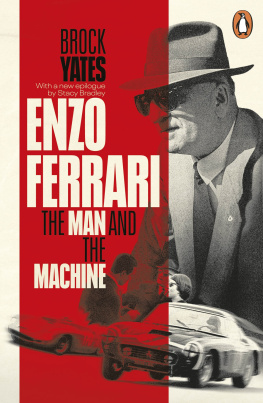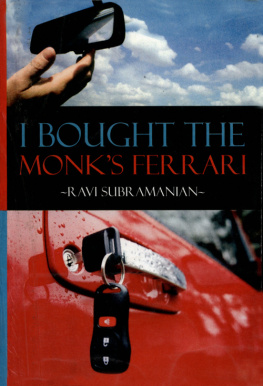Ferrari
Larry Edsall
Photography by Dennis Adler

First published in 2011 by Motorbooks, an imprint of MBI Publishing Company, 400 First Avenue North, Suite 300, Minneapolis, MN 55401 USA
Copyright 2011 Dennis Adler, MBI Publishing Company
All photographs are from Dennis Adler unless noted otherwise.
All rights reserved. With the exception of quoting brief passages for the purposes of review, no part of this publication may be reproduced without prior written permission from the Publisher.
The information in this book is true and complete to the best of our knowledge. All recommendations are made without any guarantee on the part of the author or Publisher, who also disclaims any liability incurred in connection with the use of this data or specific details.
We recognize, further, that some words, model names, and designations mentioned herein are the property of the trademark holder. We use them for identification purposes only. This is not an official publication.
Motorbooks titles are also available at discounts in bulk quantity for industrial or sales-promotional use. For details write to Special Sales Manager at MBI Publishing Company, 400 First Avenue North, Suite 300, Minneapolis, MN 55401 USA.
To find out more about our books, visit us
online at www.motorbooks.com.
Digital edition: 978-1-61060-203-7
Softcover edition: 978-0-7603-4058-5
Library of Congress Cataloging-in-Publication
Data
Edsall, Larry.
Ferrari / Larry Edsall ; photographs by Dennis
Adler.
p. cm.
Includes index.
ISBN 978-0-7603-4058-5 (sb w/ flaps)
1. Ferrari automobileHistory. 2. Ferrari
automobileHistoryPictorial works. 3. Ferrari,
Enzo, 1898-1988. I. Adler, Dennis, 1948- ill. II.
Title.
TL215.F47E37 2011
629.2222dc22
2011010555
Editors: Carmen Nickisch and
Darwin Holmstrom
Design Manager: Kou Lor
Layout by: Kazuko Collins
Printed in China
On the front cover: TR250 Testa Rossa
On the back cover: 1974 Dino GTS
On the frontis: 1981 512 Berline a Boxer
On the title page: 212 Inter
CONTENTS
INTRODUCTION

Ironic, isnt it, that Ferraris have become the most cherished of all automobiles, because the truth is that Enzo Ferrari didnt want to build cars that people would drive on city streets and country roads or that valets would park right up front at the fanciest of restaurants. All Enzo Ferrari wanted to do was to build cars that would competethat is, winon racetracks. He built those cars for his own team of drivers, though to cover the cost of such activities, he built some that he sold to others who shared his passion for the race to the finish line.
Ferrari discovered that there was even more demand for cars he built primarily for everyday driving, and here we are, more than a century beyond his birth and more than two decades since his death at the age of 90, and Ferraris latest cars, few though they may be, are eagerly purchased by the well-to-do. Those of older vintage frequently command seven figuressometimes even eightat collector car auctions around the world.
In fact, one major classic car auction company executive, whose livelihood depends on paying particularly close attention to such things, has revealed that while Ferraris comprise only a small percentage of the collector cars sold at auctions each year, they account for nearly half of the money spent by bidders at those events.
Such is the mystique of the cars that bear Enzo Ferraris last name and the prancing horse emblem he chose to place on them.
Ah, the prancing horse. Ferraris emblem was inspired by a similar insignia used by Francesco Baracca, Italian flying ace in World War I. Baracca had been a member of the Piedmont Calvary, and the rampant horse was on the planes he flew. When Ferrari was a young racing car driver, he met Baraccas parents, who were from Lugo, a hometown they shared with Ferraris own mother, who was the daughter of a wealthy farm family. Countess Baracca noticed Ferraris interest in an old airplane bearing her sons emblem, and she suggested it would be a good-luck charm for Ferrari to use it on his racing cars.
Good luck, indeed. Ferraris cars have had a charmed life, it seems, from the beginning.
Enzo Ferrari was born on February 18, 1898, at Modena in northern Italy, where his father produced metal components for bridges and other structures. Ferrari was in his late teens when his father and older brother died during a flu epidemic on the eve of World War I. When Enzo returned from service with the Italian army, he found the company in failure. He moved to Torino (Turin) seeking employment.
When Enzo was a child, his father had taken him to see auto races, igniting an early passion for fast cars and motor sports. His other passions were operaat one point he dreamed of becoming a famous singerand writing, especially about sports, which he did for a local newspaper as a teenager. In Turin, Ferrari worked for a several small automotive businesses but eventually became a mechanic, then a test driver, race car drive (in 11 seasons, he drove in 38 races and won 9 of them), racing team manager, marketing manager, and eventually a regional agent for Alfa Romeo.
Ferrari left Alfa Romeo and started his own company, Auto-Avio Costruzioni, to build components he would sell to various racing teams. But what he wanted was his own team, which he established after World War II as Scuderia (the Italian word for stable or team) Ferrari.
Although his Auto-Avio Costruzioni had built two sports cars from Fiat parts and entered them in the Mille Miglia/Grand Prix of Brescia in 1940, the first car to bear Ferraris name was the 125 S, a racing roadster powered by a V12 twin-six engine.
If the creation of such a complicated powerplant seems a huge task for a fledgling company, understand how driven Ferrari was to build the best and fastest cars. As he wrote in one of his autobiographies, I have always loved V12 twin-six engines, ever since I saw photographs of the first V12 twin-six Packard at Indianapolis back in 1914 and the Delage that came in second at Lyons in 1924. I have always loved the sound of the engine....
Ah, the sound of the engine, especially the V12, especially the Ferrari V12. Its a sound so many of us have come to love, including the authors youngest daughter, Abby, who loved the Ferraris her father sometimes would drive home when he was an editor at AutoWeek magazine. At the end of each summer, Abby would come along eagerly to the big collector car auction at Auburn, Indiana, where she could see not just one Ferrari, but a handful or even a dozen or more of them as they awaited their turn to be driven across the auction block.
This book is part of a First Gear series, meant to introduce the passion for automobiles to another generation. Enzo Ferrari had that passion, from an early age, and the cars bearing his name and the prancing horse emblem that emitted that wonderful exhaust note have ignited the emotions of Abby and millions more around the globe.













